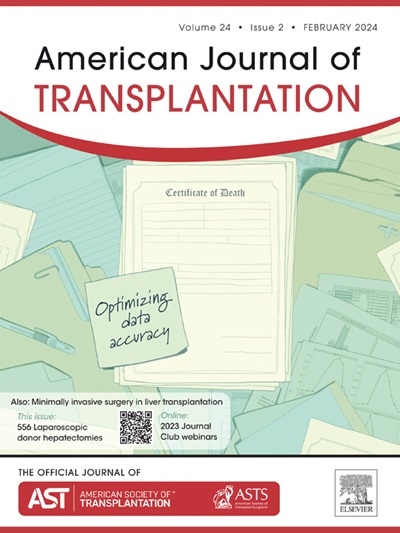Complex donor anatomy does not influence early donor or recipient outcomes after robotic donor hepatectomy at a high-volume center
IF 8.2
2区 医学
Q1 SURGERY
引用次数: 0
Abstract
With evolving expertise, criteria to select donors for living robotic donor hepatectomy (RDH) have expanded. We studied the comparative donor and recipient outcomes in RDHs with standard grafts and complex grafts. We performed 360 right lobe RDH (RRDH) of 4296 living donor liver transplantations, with 280 having >6 months follow-up. The first 53 cases were excluded as we used a different (cut-suture) technique for hepatic duct division. The subsequent 227 RRDHs were then divided into donors with standard (group S, n = 76) and complex grafts (group C, n = 151). Three donors in each group were converted to open midline incision. In groups S and C, 1 (1.3%) and 3 (1.9%) donors developed biliary complications (P = .741). Both recipient groups had similar early and late postoperative complications. Group C recipients had a nonsignificant higher incidence of late biliary complications (3 [3.9%] vs 17 [11.2%]; odds ratio, 3.09; 95% confidence interval, 0.88-10.88; P = .067). Early (<30 days) recipient mortality was similar with 4 (6.6%) in group S and 11 (7.3%) in group C (P = .755), all sepsis-related. The outcomes were similar among donors and recipients with both standard and complex grafts. With experience, RDH can be safely offered to “all-comer” donors and has the potential to become standard of care.
在高容量中心,复杂的供体解剖结构不影响机器人供肝切除术后早期供体或受体的结果。
随着专业技术的发展,选择机器人活体肝切除术(RDH)供体的标准已经扩大。我们比较了标准移植和复杂移植在RDH中的供体和受体结果。方法:我们在4296例LDLT患者中进行了360例右叶RDH (RRDH),其中280例随访超过6个月。前53例被排除,因为我们使用了不同的(切割缝合)技术来分割肝管。随后将227例RRDH分为标准移植组(S组,n=76)和复杂移植组(C组,n=151)。结果每组3例供体均转化为开放式中线切口。S组和C组分别有1例(1.3%)和3例(1.9%)出现胆道并发症(p=0.741)。两组患者术后早期和晚期并发症相似。C组患者晚期胆道并发症发生率无显著性增高[3例(3.9%)vs 17例(11.2%);OR 3.09, 95% CI 0.88-10.88, p=0.067]。早期(< 30天)受体死亡率相似,S组4例(6.6%),C组11例(7.3%)(p=0.755),均与脓毒症有关。结论标准移植和复杂移植的供体和受者预后相似。有了经验,RDH可以安全地提供给“所有角落”的献血者,并有可能成为标准的护理。
本文章由计算机程序翻译,如有差异,请以英文原文为准。
求助全文
约1分钟内获得全文
求助全文
来源期刊
CiteScore
18.70
自引率
4.50%
发文量
346
审稿时长
26 days
期刊介绍:
The American Journal of Transplantation is a leading journal in the field of transplantation. It serves as a forum for debate and reassessment, an agent of change, and a major platform for promoting understanding, improving results, and advancing science. Published monthly, it provides an essential resource for researchers and clinicians worldwide.
The journal publishes original articles, case reports, invited reviews, letters to the editor, critical reviews, news features, consensus documents, and guidelines over 12 issues a year. It covers all major subject areas in transplantation, including thoracic (heart, lung), abdominal (kidney, liver, pancreas, islets), tissue and stem cell transplantation, organ and tissue donation and preservation, tissue injury, repair, inflammation, and aging, histocompatibility, drugs and pharmacology, graft survival, and prevention of graft dysfunction and failure. It also explores ethical and social issues in the field.

 求助内容:
求助内容: 应助结果提醒方式:
应助结果提醒方式:


